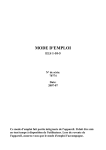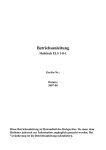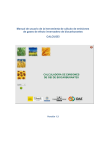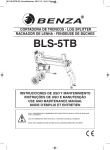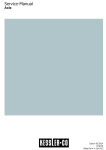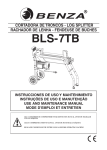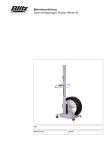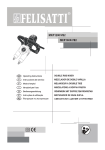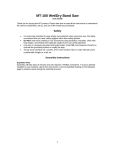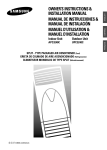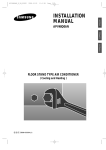Download Operating Instructions
Transcript
Operating Instructions ELS 1-10-5 Serial-N°: 70774 Date: 2007-07 These operating instructions are a component part of the lifting machine. They must be made available at all times for the operators information. The operating instructions are to be delivered on sale of the machine. Operating Instructions Contents 1 1.1 1.2 1.3 1.4 1.5 1.6 1.7 1.8 1.9 1.10 1.11 2 2.1 2.2 2.3 2.4 2.5 2.6 2.7 3 3.1 3.2 4 4.1 4.2 4.3 4.4 09.2004 SAFETY ...............................................................................................................1 SAFETY HINTS IN THESE INSTRUCTION ..................................................................1 DANGERS OF THIS MACHINE..................................................................................1 REGULATORY APPLICATION ..................................................................................2 DANGER THROUGH ACCESSORIES .........................................................................2 EMISSIONS..........................................................................................................2 SOURCE OF DANGER ...........................................................................................3 QUALIFIED OPERATORS .......................................................................................4 PERSONAL SAFETY EQUIPMENT............................................................................4 SAFETY MEASURES IN THE WORK PLACE ..............................................................4 CONDUCT IN AN EMERGENCY...............................................................................4 PICTURE SYMBOLS ..............................................................................................5 SAFETY FACILITIES...........................................................................................6 INSPECTION SUPPORT. ........................................................................................6 APERTURE RESTRICTION IN CYLINDER INLET...........................................................6 LOWERING BRAKE VALVE (WHEN ON HAND) ...........................................................6 ONE WAY FLOW RESTRICTION VALVE (WHEN ON HAND) .........................................6 FOLDING SCREEN (WHEN ON HAND) ......................................................................6 SECURING DEVICE ON WHEELS (TRANSPORTABLE MACHINES ONLY)........................6 CONTACT FRAME (WHEN ON HAND).......................................................................6 TAKING INTO USE..............................................................................................7 SETTING UP / ASSEMBLY / CONNECTING UP. .........................................................7 TAKING INTO USE.................................................................................................7 OPERATION ........................................................................................................8 LIFTING ..............................................................................................................8 LOWERING ..........................................................................................................8 ADJUSTING THE LOWERING SPEED ........................................................................9 ADJUSTMENT OF THE LIFTING END-STOP SWITCH (WHEN ON HAND)........................10 5 TAKING OUT OF USE.......................................................................................11 6 INSPECTION. ....................................................................................................12 6.1 6.2 6.3 INSPECTION BEFORE THE FIRST USE ....................................................................12 REGULAR TESTING.............................................................................................12 CHECK LIST ......................................................................................................13 ii Operating Instructions 7 7.1 7.2 7.3 7.4 7.5 7.6 7.7 7.8 7.9 8 INSPECTION / SERVICE...................................................................................14 MAINTENANCE PLAN ..........................................................................................16 CLEANING .........................................................................................................16 MECHANICAL.....................................................................................................16 MAINTENANCE OF THE HYDRAULICS ....................................................................17 OIL CHANGE INTERVALS.....................................................................................17 CHECKING THE OIL LEVEL. ..................................................................................18 OIL CHANGE .....................................................................................................18 BLEEDING THE HYDRAULIC SYSTEM .....................................................................18 CONTROL OF THE HYDRAULIC HOSES...................................................................19 FAULT FINDING ................................................................................................20 8.1 8.2 8.3 8.4 8.5 ELECTRIC MOTOR DOES NOT RUN........................................................................20 LIFTING MACHINE DOES NOT LIFT.........................................................................20 OIL LOSS ..........................................................................................................20 LIFTING MACHINE DOES NOT REACH MAXIMUM HEIGHT ...........................................21 LIFTING MACHINE WILL NOT (COMPLETELY) LOWER ...............................................21 8.6 8.7 THE CONTACT BOARD DOES NOT STOP THE TABLE SINKING ....................................21 LIFTING MACHINE SINKS STRONGLY BY PLACEMENT OF LOAD .................................22 9 9.1 9.2 9.3 GENERAL..........................................................................................................23 TRANSPORT DAMAGE ........................................................................................23 WARRANTY .......................................................................................................23 ORDERING OF SPARE PARTS ...............................................................................23 10 APPENDIX .........................................................................................................24 DIMENSION SHEET SPARE PART LIST HYDRAULIC SCHEMA ELECTRIC SCHEMA EC DECLARATION OF CONFORMITY iii Operating Instructions 1 Safety 1.1 Safety Hints in these Instruction Draws attention to the fact that disregard for these instructions could lead to serious or even deadly consequences. Danger Draws attention to the fact that disregard of these instructions could under certain circumstances lead to injuries. Caution Indicates that disregard of these instructions could lead to the damage of the machine or goods on the machine. Work that is indicated by this symbol must be carried out by a competent tradesman (electrician or industry fitter). 1.2 Dangers of this machine This machine is equipped with safety devices and is put through safety and quality control tests but there is a threat of danger by incorrect operation and misuse - for the operator or other people in the vicinity - for the machine and goods The danger zone is contained within the outer limits of the machine. All personnel concerned with the - Installation - Setting Up - Operation - Maintenance - Repair of the machine must have read and fully understood the operating instructions. 1 Operating Instructions 1.3 Regulatory Application Applications • Lifting of weights until maximum load. • Working on the raised platform • Hand Forklifts - Transporting of loads in the lowered position. Prohibited • Lifting and transportation of personnel (with the exception of lifting tables intended for this purpose on the basis of certain preparations and safety provisions) • Setting up and operation of machines in the open. Exception - machines specially constructed for this purpose • Alterations and rebuilds of the machine. Positioning of the load • Load should not overhang the platform • Unintentional shifting of the load should be prevented 1.4 Danger through accessories When the following - Rollers - Conveyer Belts - other transport facilities are used the safety devices on the machine must not be made in operational through their use. The danger zone is enlarged through the use of accessories 1.5 Emissions See dimension sheet in appendix. 2 Operating Instructions 1.6 Source of Danger Where? Mechanic Hydraulic What? Scissors arms Scissors arms / underframe Crush and shear points Danger! Loss of limbs /life Where? Hydraulic components e.g. hoses What? Because of damage oil could be sprayed out under high pressure Burns and contamination to the eyes Danger! Where? Foot Pump Current What? Operating pedals , Lifting / Lowering Slipping off pedal Danger! Injury to the leg Where? Current carrying components What? Touch Danger! Life threatening Work on the electrical and hydraulic components should only be carried out by a competent tradesman! Never - remove - alter - take out of service the safety facilities danger Always secure that the machine is out of service when - Setting up - The alteration of the employment requirements - The alteration of the operating procedure - Maintenance - Servicing - Repair 3 Operating Instructions 1.7 Qualified Operators The operator must - be over 18 years old - be instructed in the operation of the machine - have proved to the firm that he is capable of operating the machine - have clear and written instructions from the firm to operate the machine - have read and understood the operating instructions - must observe the operating instructions 1.8 Personal Safety Equipment For the operating of the machine • Safety shoes For cleaning / maintenance / repair • Safety shoes • Work gloves • Face protection 1.9 Safety Measures in the Work Place • Secure positioning of the machine • Avoid crush and shear zones between the machine and it's surroundings • Ensure that the workplace remains clean and clear of obstacles 1.10 Conduct In An Emergency Footpump E - Hydraulic Release the pump / lower pedal immediately Release the raise / lower push-button immediately Switch of at the mains / remove the plug Secure against further By raised load support the load carrying component 4 Operating Instructions 1.11 Picture Symbols Safety and Operational hints on the Lifting Table 1 2 3 4 5 1 Prohibited: Stepping on / Lifting of personnel! (with the exception of lifting tables intended for this purpose on the basis of certain preparations and safety provisions) 2 Accumulation of weight forbidden! 3 Prohibited: Staying / Grasping under an unsecured table! 4 Load must be evenly distributed (surface load)! 5 Lower the table onto the inspection support when carrying out repair and maintenance work alone! 6 You will find the maximum permissible load at the appendix of these instruction. 5 Operating Instructions 2 Safety Facilities. 2.1 Inspection Support. The unloaded machine should be lowered onto the inspection support before all repair and maintenance work! (see section 7) 2.2 Aperture restriction in cylinder inlet Restricts the oil flow by the rupture of a hydraulic hose 2.3 Lowering Brake Valve (when on hand) Fixed adjusted limitation of the oil flow (lowering speed) 2.4 One Way Flow Restriction Valve (when on hand) Adjustable restriction of the oil flow (lowering speed) Attention : adjustment is dependent on load ! 2.5 Folding Screen (when on hand) Prevents grasping under the raised table. 2.6 Securing Device On Wheels (transportable machines only) The securing device (brake) prevents the unintentional movement of the machine. 2.7 Contact Frame (when on hand) The contact frame stops the lowering of the table when it comes in contact with an obstacle. Raise the table with the "raise" button and remove the obstacle then complete the lowering process 6 Operating Instructions 3 Taking into use. For technical details see dimension sheet in appendix 3.1 Setting up / Assembly / Connecting Up. (230 V / 400 V) During intallation of the lifting table, it is important that the base frame (when on hand) in the area of the fixed bearings and the runner wheels is adequately supported with appropriate packing plates. Danger Failure to comply with this instruction will result in loss of machine-warranty! • Before taking into use it will be necessary to remove the crane parts (when onhand), which tighten the under frame together with the top frame. • Position the machine on a firm level underground • The machine should be adjusted so that it is level • Bolt the machine onto the concrete floor • When the machine is to be connected into the factory ring main, - connect in a lockable mains switch to prevent unauthorised use - This should only be performed by an electrician Danger • • Danger of stumbling because of cable. • Damage to cable, e.g. because of falling objects (tools etc.) • It is forbidden to wind the cables around mechanical components Every feed wire must be secured by 16 A. Have you read the operating instructions and above all the safety points and above all understood them? Then you can take the machine into use 3.2 Taking into use. • Produce the electrical connection (put the plug in) • Check the motor rotation (by three phase 400V) - Control by use of the red arrow on the motor casing - when incorrect alter by changing the phases in the plug (electrician only) • Now you can take the machine into use. An adequate and safe connection of the earth cable to the workpiece must be guaranteed when using a lifting table as a welding station. 7 Operating Instructions 4 Operation • No personnel should be within the danger zone when raising or lowering the table • Observe the picture symbols on the lifting machine Danger Short, jerky raising and lowering is forbidden . The machine then begins to oscillate and damage to the machine could be a result . • Operate the machine with the remote cable push button control (dead mans operation) • Observe the lettering (picture symbols) 4.1 Lifting 4.2 Lowering 8 Operating Instructions 4.3 Adjusting the lowering speed (when on hand) Never grasp the table during the raising or lowering process. Danger The lowering speed of the lifting device must not exceed 150 mm/s. The recommended lowering speed is 50 mm/s. Note: It is not possible to use the maximum lowering speed allowed with some units due to their design. An adjustment of the lowering speed should not be necessary (adjusted at works). Should an adjustment be necessary e.g. through replacement of the flow control valve, then the following should be observed. The one-way flow control valve can be found on the pressure outlet of the hydraulic pump. • raise load • loosen securing screw • adjust valve as required securing screw • • • • tighten the securing screw lower the load measure the lowering rate with a stopwatch if necessary repeat the above procedure 9 Operating Instructions 4.4 Adjustment of the lifting end-stop switch (when on hand) Never grasp the table during the raising or lowering process. Danger Select the contact point of the electrical switch so, that the roller does not come into contact with the mechanical end-stop. The end-stop switch is there to limit the lifting of the table. The switch can usually be found on the fixed pivot end of the table. This position can change in the case of a special construction table. The end-stop switch is adjusted by shifting it's position in the slotted rail. • • • • • Loosen fixing screws Adjust switching position Tighten fixing screws Check adjustment If necessary repeat the above procedure until correct. Befestigungsschraube Endschalter Langlochschiene Festpunkt = fixing screw = End-stop switch = Slotted rail = Fixed pivot 10 Operating Instructions 5 Taking out of use. machine with footpump for: maintenance -cleaning -inspection -repair -battery charging -remove load -put inspection strut into position -lower onto inspection strut for: end of work lower machine fold up the foot pedal 12 V - remove load - put inspection strut into position - lower onto inspection strut lower machine battery main switch into "off" position 230 V 400 V - remove load - put inspection strut into position - lower onto inspection strut lower machine remove mains plug and or mains switch "off" 11 Operating Instructions 6 Inspection. 6.1 Inspection before the first use The machine is tested by the manufacturer before delivery Machines that are delivered not ready for use should be inspected by a qualified person in the following aspects ; - correct construction - correctness for use 6.2 Regular testing Regular testing of machines at intervals of at the longest one year should be carried out by a qualified person. • use the check list on the following page • make a photo copy of the list • note top right on the check list - Lfd N° (check list number) - machine type - serial number • cross each point when it is in order • put the machine back into use only when each point has been crossed • when completed put the check list into the appendix of these operating instructions 12 Operating Instructions 6.3 Check List Lfd.-Nr°: ....................... Machine Type: ........................ Mechanical O O O O O O O O Serial-N.°: ........................ Cylinder pins secure All lever pins secure Inspection strut in order (when on hand) Wheel brakes in order (when on hand) Machine clean Stickers intact and readable Welded construction undamaged Machine holds the load in the maximum raised position for at least 10 minutes O Protective folding screen undamaged (when on hand) O All bolted connections tight Hydraulic O O O O O No leaks in the hydraulic system Oil level correct No damage to the hoses (see 7.5) Lowering speed correctly adjusted Flow control valve secured (when on hand) Electric O O O O Cable connections tight Cables secured No damage to cables Contact rail in order (when on hand) O Battery is clean and in order (when on hand) O All functions inspected without query Inspection date, Inspector (signature) 13 Operating Instructions 7 Inspection / Service Work should only be carried out on the lifting table when it is unloaded and the issued inspection strut is in it’s designated position. The inspection strut can be found on or near the under frame. Danger Operation: • The unloaded scissor lift should be fully raised • position the strut in the lower pocket. • hold the strut in a vertical position and lower the scissor lift. Ensuring that the strut is in it’s correct position! Should it not be possible to raise the scissor lift using it’s own drive, then the platform should be raised using some suitable means (hydraulic jack or crane). The platform should be raised from the fixed pivot end. It should be noted that a vacuum is produced in the cylinders when the scissor lift is raised using an external method and that they do not support the scissor lift hydraulically (on a column of oil). The scissor lift should be raised from the inspection strut using it’s own hydraulic drive (or an external hydraulic drive) when service work is completed to ensure that the cylinders support the weight of the scissor lift. LIFE THREATENING DANGER The inspection struts should never be removed (by hammer blow or cutting) before the lifting table has been raised from the service position using it’s hydraulic drive. An uncontrolled lowering of the scissor lift and platform could be the result. Danger The inspection strut can be removed: • by first raising the scissor lift a short distance. • then remove the strut and return it to it’s stowed position. The operator should under no circumstances be positioned within the lifting table when performing this task. 14 Operating Instructions Possible methods of using the inspection strut Dia. 1: Inspection strut between upper and lower frame. Dia. 2: Inspection strut between scissor arms. Abb. 3: Inspection strut between roller and frame. 15 Operating Instructions 7.1 Maintenance Plan What? When? Description Cleaning When necessary 7.2 Check Bushes Every 250 hours 7.3 Yearly 7.6 Check oil level top up Hydraulic oil change Inspect oil hoses 7.7 -------Yearly 7.9 7.2 Cleaning Secure that the machine is out of use Danger Clean - your machine regularly - especially the stickers (picture symbols) on the machine.(when the stickers are no longer readable please order new ones, order number see spare parts lists) - working areas of the rollers 7.3 Mechanical The machine is delivered with maintenance free bushes. Therefore the bushes only have to be checked regularly (250 working hours) for wear. 16 Operating Instructions 7.4 Maintenance of the hydraulics Hydraulic oil can cause irritation and skin rashes. Avoid prolonged skin contact and wash the skin thoroughly after contact. Danger Wear protective clothing! (see chapter 1.8) Protect the environment: The handling and disposal of mineral oils is covered by laws. Dispose of old oil at an authorised disposal unit. Information can be found from the responsible authority. Be careful not to spill any hydraulic oil. Make precautions to catch any spilt oil (oil resistant covers, drip tray etc.) This machine is filled with bio-oil on synthetic base This oil is not mixable with water. The biological removable hydraulic-oil is mixable with mineral-oil, but then it will loosen his biological removability. The following or equivalent can be used Total Biohydran TMP 46 BP Biohyd SE 46 Fuchs Plantohyd 46S Esso Hydraulicoil HE 46 Total Equivis UVS 46 Shell Naturell HF-E 46 → in this machine 7.5 Oil Change Intervals The oil must be changed after the first 50 working hours, thereafter at intervals of 500 hours or at the latest every 2 years 17 Operating Instructions 7.6 Checking the oil level. • • • • Raise the table into its uppermost position. Read the position in the oil gauge pipe The level must be at least in the lower quarter of the pipe When necessary top-up the oil Breather bung Tank Oil gauge pipe 7.7 Oil Change • Lower the table without load onto its inspection strut. • Position a drip tray under the hydraulic cylinder • Loosen the hose on the cylinder and lay into the drip tray • Operate the pump (raise) until no more oil is discharged from the hose • Reconnect the hose • Remove the breather bung from the tank • Fill up with oil • For volumes see dimension sheet in appendix • Replace the breather bung • Bleed the hydraulic system 7.8 Bleeding the hydraulic system • Lower the table without a load onto the inspection strut. • Loosen the bleed screws on the cylinder one or two turns. • When no bleed screws are on hand the cylinders are so constructed as to bleed themselves. • Operate the pump (raise) until oil is discharged from the bleed screws without air bubbles. • Check the oil level. • Top up when necessary. 18 Operating Instructions 7.9 Control of the hydraulic hoses A yearly check on the hydraulic hoses for a safe working condition is stipulated. The check must be carried out by a qualified tradesman. Control the following • Can the following damage be observed on the outer mantel of the hose rips, kinks, cuts, unbending, abrasions or splitting? • Are there any deformities in the hose when under or not under pressure? • Are there any leaks between the hoses and the fittings? Is the hose coming out of the fitting? • When there is any damage the hose should be changed. • Depending on the requirements the hoses should be changed at the latest after six years. 19 Operating Instructions 8 Fault Finding Work on the electrical and hydraulic components should only be carried out by a competent tradesman! Danger Observe the safety instructions 8.1 Electric motor does not run Cause Cure Current supply broken Check: • Feed line • Fuse • Circuit breaker Motor is faulty Exchange hydraulic pump 8.2 Lifting machine does not lift Cause Cure Table is overloaded Reduce load Motor is faulty Exchange hydraulic pump Leaks in the hydraulic system See 8.3 Pump does not produce pressure Exchange hydraulic pump Motor rotates in the wrong direction Check the motor rotation (by three phase 400V) - Control by use of the red arrow on the motor casing - when incorrect alter by changing the phases in the plug (electrician only) 8.3 Oil loss Cause Cure Leaks in the hydraulic system • • • • re-tighten fittings replace cylinder seals exchange cylinder exchange hoses 20 Operating Instructions 8.4 Lifting machine does not reach maximum height Cause Cure Oil level too low (see point 8.3) • top-up oil 8.5 Lifting machine will not (completely) lower Cause Cure Machine is blocked by inspection strut Raise table and remove inspection strut Obstructions (dirt) in the rollers working surfaces Clean working surfaces Contact board has been activated by an obstacle Raise table, remove obstacle and test the function of the contact board Contact board switch is defect Exchange switch Magnet lowering valve defect Exchange valve The neutral is incorrectly or not connected (only 230 V / 400 V) Check feed 8.6 The contact board does not stop the table sinking Cause Cure Contact board is defect (e.g. bent) Exchange contact board The fixing screws of the contact board switch are loose re-tighten screws and align contact board switch Contact board switch is defect Exchange switch Contact board switch cable is defect Replace cable 21 Operating Instructions 8.7 Lifting machine sinks strongly by placement of load Cause Cure Air in hydraulic system • Bleed hydraulic system • Drive table repeatedly (2-3 sec) against the mechanical end-stop Hydraulic feed hose too long (only tables whose pump is outside the table) • Hoses of more than 3m from table to pump should be avoided 22 Operating Instructions 9 General 9.1 Transport Damage All deliveries are to be insured by the customer. We must turn down any possible claims concerning transport responsibility. Our responsibility is restricted to the hand - over of the machine in brand-new condition to the shipping agent. Should you discover any damage to the machine, do not use it and contact the shipping agent concerning the damage. 9.2 Warranty Every machine is covered by a 12 months warranty against material faults and incorrect assembly. The warranty covers all parts that are returned post free within twelve months for inspection. The parts will then be inspected by us to determine whether the parts were damaged under normal use. The warranty will be declared void if the parts are found to have been overloaded, handled incorrectly or that replacement parts have been assembled incorrectly. 9.3 Ordering of spare parts Please give the following details when ordering; Type: Load: Year of construction: Serial Number: Part description: Order Number: The address for ordering is to be found on the cover of this operating instructions. 23 Operating Instructions 10 Appendix 24 Technische Daten (Technical ratings) ELS 1-10-5 Mechanik / Mechanics Traglast (maxload): ................................................................. 1000 kg Belastungsart (nature of load):................................................ Flächenlast / surface load Bauhöhe (building height): ...................................................... 200 mm Nutzhub (effective stroke): ...................................................... 1000 mm Tischplatte Maße (platform): ................................................... 5 x 1500 x 800 mm Glattblech / plain sheet Unterrahmen (bottom frame):.................................................. 1500 x 750 mm Hubzeit belastet (lifting time, loaded): ..................................... ca. 13 sec. Senkzeit belastet (sinking time, loaded):................................. ca. 12 sec. Gewicht (weight):..................................................................... ca. 290 kg Elektrik / Electric Leistung Hydraulikaggregat (power): ...................................... 2,3 kW Stromaufnahme (current consumption): ................................. 5,5 A Schutzart (enclosure): .............................................................IP 55 Betriebsspannung (operating voltage): ................................... 400 V Steuerspannung (control voltage): .......................................... 230 V Steuerung (control system): .................................................... Totmann, Handtaster (3m) Deadman, hand switch (3m) Hydraulik / Hydraulic Betriebsdruck (working pressure): .......................................... max. 180 bar Anordnung Aggregat (positioning of drive unit):...................... innerhalb / inside Ölfüllmenge (oil filling): ............................................................ 2 l Ölsorte (kind of hydraulic oil):.................................................. Bioöl / biooil Hydraulikzylinder (hydraulic cylinder):..................................... 1 x Ø 80 x 250 mm Hub / stroke Stückliste Mechanische Bauteile Pos. 1 2 3 Stückzahl 1 1 8 5 4 4 5 5 5 5 6 6a 6b 7 8 9 13 14 14 14 14 14 4 2 2 1 2 2 2 4 4 4 8 4 8 2 1 1 1 1 1 Benennung Schere, außen Schere, innen Fest- und Laufrollenbolzen Passscheibe Buchse Buchse Scherenachse Scheibe Federring 6kt.-Schraube Laufrolle mont. Laufrolle Buchse Scheibe Buchse Sicherungsmutter Buchse Zylinderbolzen 6kt.-Schraube Federring 6kt.-Schraube Sicherungsmutter Best.-Nr. 50.11.272 50.11.222 10.16.160 Bemerkung 10.40.510 10.02.294 10.02.283 55.57.231 12.40.137 12.40.440 12.53.041 42.99.474 12.09.690 10.02.287 12.40.136 10.02.287 12.55.109 10.02.294 50.82.064 12.51.081 12.40.425 12.50.281 12.55.042 DIN 988-35x45x1 GSM 40440-30 GFM 4044-40 mit Bund DIN 668-S235JRG2K-40x621 ISO 7094-16-100HV DIN 128-A16-FSt ISO 4017-M16x35-8.8 Ø 45 x 70 Ø 70 x 20 GSM 3539-20 17 DIN 7349-St GSM 3539-20 DIN 985-M16-10 GSM 4044-30 Ø 40 x 110 ISO 4017-M10x30-8.8 DIN 128-A10-FSt ISO 4014-M8x80-8.8 DIN 985-M8-8 Stückliste Mechanische Bauteile Pos. 1 2 Stückzahl 1 1 1 Benennung Oberrahmen Unterrahmen Inspektionsstütze Best.-Nr. 50.02.556 50.02.375 56.67.295 Bemerkung 1500 x 800 mm 1500 x 750 mm Kontaktleiste Art.-Nr. 12.55.038 (L=25 mm) 12.55.039 (L=40 mm) 12.23.028 12.15.539 12.16.521 12.23.503 10.28.084 19.27.661 Stückliste Hydraulische Bauteile Pos. 1 2 3 4 5 5a Stückzahl Benennung 1 Hydraulikaggregat 1 Senkbremsventil 1 2/2-Wegemagnetventil 1 Leitungsbruchsicherung 1 Hydraulikzylinder 1 Dichtungssatz für Zylinder Best.-Nr. 11.19.386 12.19.436 10.19.463 10.19.292 Bemerkung 2,3kW/400V/50Hz 8,5 l/min SV 98-2006 230 V AC 3/8“ 11.19.084 50.97.091 Ø 80 x 250 mm Hub Ø 80 mm Hydraulikbauteile Stück 1 Art.-Nr. 10.19.103 L = mm 1050 DN 8 A M 16x1,5-SW 19 B M 16x1,5-SW 19 Einstellbare T-Verschraubung Stück Art.-Nr. Baureihe 1 12.19.240 L DN 8 A M 16x1,5 B M 16x1,5 DN 8 8 A 1/4” M 14x1,5 B M 16x1,5 M 16x1,5 DN 8 8 A 1/4” 3/8” B M 16x1,5 M 16x1,5 DN 8 A 3/8” B M 16x1,5 DN 8 A M 16x1,5 Gerade Einschraub-Verschraubung Stück Art.-Nr. Baureihe 1 12.19.265 L 1 12.19.267 L Gerader Einschraubstutzen Stück Art.-Nr. Baureihe 1 12.19.235 L 1 12.19.258 L Winkel-Schwenkverschraubung Stück Art.-Nr. Baureihe 2 12.19.261 L Steckkupplung (Messanschluss) Stück Art.-Nr. Baureihe 1 12.19.434 L Magnetventil Stück 1 Art.-Nr. 10.19.463 A 1/4“ B 1/4“ Bemerkung SV98-2006 / 230V, 19 W, 0,1 A Senkbremsventil Stück Art.-Nr. 1 12.19.436 A 3/8” B 3/8” Bemerkung 8,5 l/min Stück Art.-Nr. 1 10.19.292 A 3/8” Spaltmaß Bemerkung Leitungsbruchsicherung Haftschilder Art.-Nr. 10.33.334 10.33.358 10.33.242 10.33.237 EC Declaration of Conformity Conforming to: EC-Directives – Machines 98/37/EG, appendix II A EC-Directives – Electromagnetic compatibility 89/336/EWG, EC-Directives – „Low voltage“ 73/23/EWG We: Gruse Maschinenbau GmbH & Co. KG Dibbetweg 32 31855 Aerzen Germany declare in general responsibility, that the product ELS 1-10-5, convered by this declaration confirms to the Health and Safety rules laid down by the directives above. The following Norms were used for the proper implemention of the EC Directives on Health and Safety: • DIN EN ISO 12100-1 (2003) • DIN EN ISO 12100-2 (2003) • DIN EN 294 (1992) • DIN EN 349 (1993) • BGR 500 (2004) • DIN EN 1570 (1998) • DIN EN 1570/A1 (2004) • DIN EN 60204-1 (1997) • BGV A3 (1997) • DIN EN 61000-6-2 (2001) • DIN EN 61000-6-4 (2001) Gruse Maschinenbau GmbH & Co. KG F. Kraft 2007-10-19









































